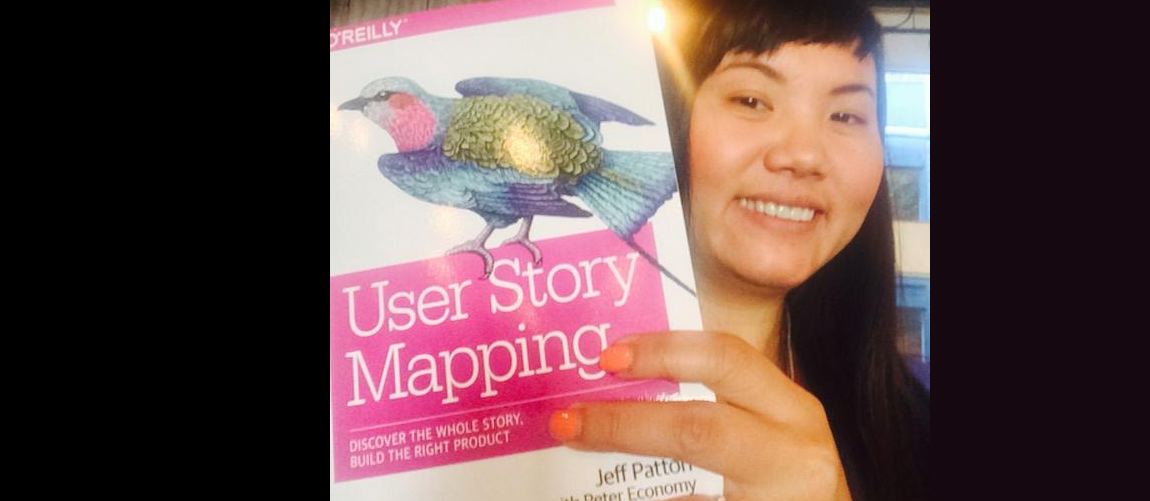 I wrote a book. This is my friend Liya holding her copy. I’m not nearly as pretty.
I wrote a book. This is my friend Liya holding her copy. I’m not nearly as pretty.
It’s About User Story Mapping
I’m known for coining the term “story mapping,” and the book is about that. I may have been lucky enough to coin a sticky term, but the term describes a way of work with product design that I’ve seen lots of smart people doing for years.
Story maps solve one of the big problems with using user stories in agile development – that’s losing sight of the big picture. Story maps look at a product or feature from the users’ perspective. Building a story map asks the story mapper to think through the experience of using the product from their users’ perspective. And, it turns out that solves a lot of problems with software development.
It’s About Saving the Story in Agile Development
I found I couldn’t take on the concept of story mapping without setting the record straight about user stories in Agile development. So the second half of the book is about that.
Stories have gone sideways. I believe that how they’re used today is pretty far from how they were intended to be used. I’m hoping, really hoping, that this book helps reverse the slow death-spiral that stories are on. I’m really hoping that we can all start getting the value out of stories that Kent Beck, and others that originally gelled the concept, intended.
“Best to Market Trumps First to Market”
I first heard this from Alan Cooper. And I hope it’s true. Because my book comes out over a decade ofter the best selling books on user stories.
As it turns out, the book I wrote is reasonably good. Some wonderful people, who I did not pay anything to say what they did, said things like this:
Lisa Crispin @lisacrispin
“Reading @jeffpatton’s User Story Mapping for 2nd time. Trying to imprint all this goodness on my brain so it’s always in my mind.”
Adam Taylor @admtaylo
“Just finished reading ‘User Story Mapping’ by @jeffpatton. Great writing style with many wise words. Highly recommend.”
Bill Higgins @BillHiggins
“Really loving @jeffpatton’s new book ‘User Story Mapping’. Best software-related book I’ve read in a long while.”
Pirkka Rannikko Amazon Review
“If you’re going to read just one book about software (requirements) pick this.”
J. Constant Amazon Review
“The Definitive Guide for Building and Using Story Maps.”
I’m humbled. And, I’m really grateful that they took the time to buy the book, read it, review it, and tweet about it. It helps me. But, look, it’s not about me. It’s about saving stories from the template zombies (that have turned them into yet another annoying way to express software requirements), and instead having really high-fidelity conversations about how our product helps people.
Story maps build on the concept of stories. If you’re using stories well, story maps are a natural next step.
My book was delivered late.
For those of you who’ve known me for a while, you’re likely thinking “Geez, it’s about time. He’s been saying he’s working on a book for years. I’d pretty much given up on him.” If you were thinking that, I was too.
I can write a couple thousand words without too much trouble. But something about writing a book really turned me stupid. I can best describe my writing as taxidermy. That is to say, I took a subject that’s living and vibrant, killed it, and stuffed it. The best I could hope for was that it was lifelike. It was my new friend, Peter Economy, who helped me break my book-writing funk. After telling Peter that I can speak and teach and that people really seem to get a lot out of it, Peter made what’s now a dead obvious suggestion. “Let’s just talk through it, and transcribe what you say.” And that’s what we did. If you read the book, you all owe Peter lots of thanks because I promise you that you’d have been bored stiff if it weren’t for his help.
The book is hand illustrated.
For those of you who’ve seen me teach or present recently, you may know I rely on live drawing to support what I’m talking about. The book has lots of hand-drawn pictures and hand-annotated photos.
The book has three forewords.
Yes, three! Three of my heroes that represent the best product management, user experience, and software engineering have to offer: Marty Cagan, Alan Cooper, and Martin Fowler. The forewords are worth the price of the book.
The book includes other people’s stories. The book is laced with stories told by some of the people I’ve been lucky enough to learn from over the last decade and every story relates a good idea ripped from their personal experience. Because you shouldn’t trust me, these stories – written in their own words – tell how they’re using stories and story mapping in their companies. The tips you’ll get from the contributions are also worth the price of the book.
The book was published by O’Reilly, which is an honor, too. Having an O’Reilly label on your book is like having an Armani label on your suit. I’m glad my book is on the same rack as so many other stellar books. And, I’m grateful O’Reilly took a chance on me.
You should buy a copy…
Hoping you buy the book and review it if you find some useful things in it. Or, even if you don’t. Together we can make the software development world safe for people who care about making good products. Direct Link to the Book at Amazon.com



